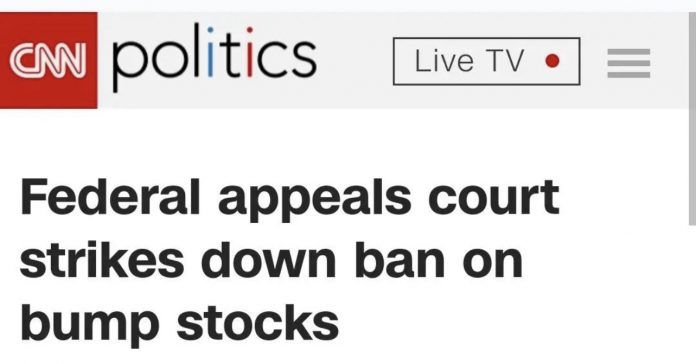
A federal appeals court on Friday struck down a ban on bump stocks, devices that essentially allow shooters to fire semiautomatic rifles continuously with one pull of the trigger.
No, CNN, they essentially allow you to pull the trigger really fast. That’s why the 5th Circuit had to check the ATF here.
A majority of the full US 5th Circuit Court of Appeals said that bump stocks were not covered by the law that the Bureau of Alcohol, Tobacco, Firearms and Explosives used to put the regulation in place.
“A plain reading of the statutory language, paired with close consideration of the mechanics of a semi-automatic firearm, reveals that a bump stock is excluded from the technical definition of ‘machinegun’ set forth in the Gun Control Act and National Firearms Act,” Judge Jennifer Walker Elrod wrote in the majority’s opinion.
Three judges on the circuit court dissented from the ruling.
This decision comes after the US Supreme Court declined to consider a challenge to the federal ban in October. The high court has consistently denied cases challenging the bump stock ban in recent years.
The ATF banned bump stocks in 2019. Then-President Donald Trump had ordered a review of the devices after a mass shooting in 2017 in Las Vegas, in which a shooter armed with semiautomatic weapons and bump stock devices opened fire from his hotel suite onto outdoor concertgoers, killing 58 people and wounding hundreds of others.
What does this mean?
This ruling will not undo the economic damage to manufacturers of bumpstocks, it won’t fix ones that were destroyed or given up. I don’t expect the federal government to be eager to cut checks to compensate for that either. So in those respects this victory comes too late.
But the bumpstock wasn’t a particularly expensive gimmick and it remains a gimmick. It was always for the fun of turning money into noise.
Where the victory exists is that the courts have put a firm check on the ATF’s ability to legislate by regulation rather than where that duty actually resides, in congress. The ATF can’t invent language or make something function in a way that it doesn’t. A bumpstock allows you to pull a trigger very fast and have a high rate of fire. A machine gun has a high rate of fire if you hold down the trigger. Those are two mechanically distinct things and just because the result is ‘high rate of fire’ does not make them same. This is as silly as trying to give manual transmission vehicles a different speed limit than automatic transmission ones, but we also tax and banned any automatic transmission built after 1986.
The ATF also recently kicked the can on their publication of their pistol brace rule. Their ability to shoehorn braced firearms into the NFA, and into a new category that doesn’t exist within the NFA, has just been severely depleted. Braced pistols and braced firearms are wildly more popular than bumpstocks were, have a far more practical purpose that touches on ADA compliance, and required the ATF to write reams of new policy. Those new policies, laws in their own right because they are not within the text of the laws themselves, are what the 5th Circuit told the ATF that the ATF cannot do. They cannot create law, they can enforce law. It is Congress’ job to create law, so the Congress must write it, and the President must sign it, and then courts must sustain it.
The ATF’s role in all of this is simply enforcement at the Federal level. That’s it, do as the law says.



